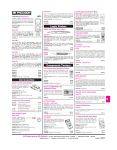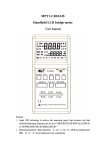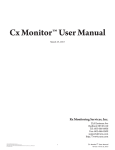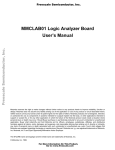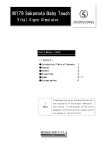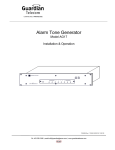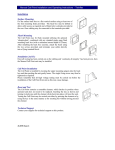Download Viking CTG-2 Specifications
Transcript
TECHNICAL Practice TELECOM SOLUTIONS Practice FOR THE CTG-1 Clock Controlled Tone Generator 2 1 S T C E N T U RY January 9, 2004 Add Time Controlled Alert Tones and Emergency Tones to Your Paging System Viking's model CTG-1 is a clock controlled tone generator designed to provide accurately timed alert tones or buzzer sounds over an existing paging system. The CTG-1 can be programmed to output single, double or triple alert tones or buzzer sounds with up to 128 events in a 24 hour period. These tone/buzzer sounds are ideal for indicating the start and end of shifts, break times, lunch periods, etc. for factories, schools, or any business requiring an audible indication of specified times. Each day of the week can be programmed to either on or off, allowing you to turn off the alert tones during specific days of the week (weekends, etc.) The CTG-1 has three contact closure inputs for triggering an emergency siren, evacuation signal or a door bell sound. Features • Accurate 24 hour digital time clock displays hours and minutes • User programmable 24 hour, 128 event timer • Programmable day of week on/off feature • Programmable single, double or triple alert sound output (selectable tone or buzzer) • Three contact closure controlled sounds: 1) Emergency siren (yelp) sound 2) Temporal (slow whoop) evacuation signal *NFPA/ANSI compliant when used with supporting equipment 3) Doorbell (chime) sound • Volume controllable, 600 ohm line level audio output • Non-volatile programming memory • Battery backup for maintaining clock time • Battery backup charging circuit for charging 9V NiCad/NiMh batteries • DPDT relay contacts for muting paging or background music during event tones Applications • Signal the beginning and end of class periods, breaks, and lunch periods for schools • Signal the beginning and end of shifts, breaks, and lunch periods for factories and other businesses • Provides a door bell and/or alarm sounds over an existing paging system, for such applications as door entry, fire, severe weather, etc. • Use with Viking's DVA-2WA to provide timed messages (Fax Back Document 110) Phone...715.386.8861 h t t p : / / w w w. v i k i n g e l e c t r o n i c s . c o m Specifications Power: 120V AC/13.8V AC 1.25A UL listed adapter provided Dimensions: 133mm x 91mm x 44mm (5.25” x 3.6” x 1.75”) Weight: 0.9 Kg (2 lbs) Environmental: 0°C to 32°C (32°F to 90°F) with 5% to 95% non-condensing humidity Connections: 10 position cage clamp terminal strip Battery Backup: 9V alkaline or NiCad rechargeable battery (not included) maintains clock time for over 8 hours Time Base: 60Hz AC power line Time Base Battery Backup Accuracy: +/- .001% Audio Output: 600 ohm with volume adjust potentiometer, maximum level = 0.4 dBm/1.05Vrms across 600 ohm load Relay Output: DPDT rated 125V AC, 30 W (resistive load) Installation Internal Battery Charge Jumper: Factory set default is OFF. Note: For rechargeable batteries, move the Battery Charge shunt to the ON position. Display: Shows clock, event time and mode settings. Mode Button: Press to place the CTG-1 in the Lock, Set Time, Set Day, Set Events or Review/Cancel modes. Clock and Event Time Setting Buttons: Press the + or -/CANCEL buttons to increase or decrease time. The -/CANCEL switch is also used to cancel an alert tone/buzzer sound event when reviewing programming. VIKING © CLOCK CONTROLLED TONE GENERATOR MODEL CTG-1 PM + MODE Battery Charge Secondary Jumper Relay Contacts J6 ON 12:00 TIME -/CANCEL Internal Secondary Relay Contacts: These activate in conjunction with pins 3, 4 and 5. You may solder to these PCB pads if a second set of relay contacts are required. OFF 3 Normally Open 1 Common 2 Normally Closed LOCK Alert Tones Programming Buttons: After setting an event time, press SINGLE, DOUBLE or TRIPLE to program 1, 2 or 3 alert tones/buzzer sounds for that event time. Secondary Button Functions While in the SET DAY Mode: The SINGLE button is used to select between day (1-7) or on/off. The DOUBLE button is used as a one time setup to program today’s day of the week. SET TIME SET DAY ALERT TONES SINGLE DOUBLE SET EVENTS TRIPLE REVIEW/CANCEL 1 9V BATTERY BACKUP 2 3 4 5 6 7 8 9 10 ALERT TONE VOLUME 10 - Common 9 - Emergency Siren (Yelp): Continuous while shorted to pin 10 (common). 9V Battery Backup Connection: A standard alkaline or rechargeable (NiCad/NiMh) 9V battery must be installed here to maintain the clock time during power outages. 8 - Evacuation Sound (Temporal Slow Whoop): Continuous while shorted to pin 10 (common). 7 - Doorbell Chime Sound (Ding Dong): Repeated continuously while shorted to pin 10 (common). 6 - Alert Tone/Buzzer*: Short to pin 10 (common) for buzzer sound, leave open for tones. 5 - Normally Open Relay Contact CTG-1 Output Volume Control: Turn clockwise to increase volume of alert tones/buzzer sounds, emergency and door bell (chime) sounds (see diagram below). 4 - Common Relay Connection 3 - Normally Closed Relay Contact 1 & 2 - 600 Ohm Audio Out Pair: Line level output, connect to input of paging amplifier. * Note: When the alarm buzzer is selected (pin 6 shorted to pin 10), a double or triple programmed event will be sounded twice, approximately three seconds apart. A. Typical Installation on the Paging Port of a Phone System Connect the CTG-1 between your phone system and your paging amplifier as shown in the diagram below. A 9V battery must be installed in the CTG-1 to maintain clock time during a power outage. Either a standard or rechargeable 9V battery will maintain the clock time for over 8 hours. Note: When using a rechargeable 9 volt battery, the battery charging jumper must be in the ON position (see diagram above). When using a non-rechargeable 9 volt battery, this shunt must be in the OFF position. PA-2A Paging/Loud Ringing Amplifier System VIKING © VIKING © CLOCK CONTROLLED TONE GENERATOR MODEL CTG-1 PM PAGING VOLUME -/CANCEL + MODE RINGING VOLUME LOCK VIKING ELECTRONICS HUDSON, WI 54016 MIN SET TIME MIN MAX MAX TRUNK / PAGING PORT PAGING HORN SINGLE 600 OHM AUDIO OUTPUT DRY CONTACT CLOSURE INPUT NIGHT TRANSFER SWITCH INPUT POWER 13.8V AC 1 2 3 4 5 6 7 8 9 10 POWER 4-6 DOUBLE SET EVENTS TRIPLE REVIEW/CANCEL 9V Battery JP1 9V BATTERY BACKUP RINGING LINES 1-3 SET DAY ALERT TONES PAGING - LOUD RINGING AMPLIFIER SYSTEM TALK BATTERY ALERT TONE WARBLE / CHIME 12:00 TIME MODEL PA-2A 1 2 3 4 1 2 ALERT TONE VOLUME 3 4 5 6 7 8 9 10 Dry Contact Closures from Alarm Equipment, Doorbell Switch, Etc. Common Volume Control Siren Evacuation Signal -or- Doorbell Input of Paging Amp Paging port output of PABX/KSU Alert Tone/Buzzer Sound Select (open = tones, closed = buzzer sounds) Programming A. Setting the Clock Time 1. Press the MODE button repeatedly until the SET TIME indicator lights. 2. Increase or decrease the clock time by pressing the + or -/CANCEL button until the desired time is displayed. 3. Leave the set time mode by pressing the MODE button. Note: Either the + or -/CANCEL button MUST be pressed at least once prior to leaving the set time mode. The clock will then start to run the moment you leave the set time mode, allowing you to synchronize the CTG-1 with your building clocks. B. Setting the Day of the Week Note: This step is only required if you want to turn off the Alert Tones on certain days of the week. 1. Press the MODE button repeatedly until the SET DAY indicator lights. 2. A flashing “A” indicates all 7 days of the week are “on” and today’s week day has not been set. The day of the week has already been set if a flashing number (1-7) and “on” or “of” are displayed. 3. Select today’s day of the week using the TIME (+ and -/CANCEL) buttons. As a general rule, Sunday is day 1 and Saturday is day 7. When the correct day of the week is flashing on the display, set it by pressing the DOUBLE alert tone button. The week day number and “on” will now be displayed. Note: The day of the week setting is a one time set up and does not need to be reset unless you have experienced a brown out long enough to discharge the 9V battery backup (approximately 8 hours). To reset the day of the week, you must power down the CTG-1, remove the 9V battery and repeat steps 1-3 above. C. Turning the Alert Tones On/Off for Specific Days of the Week 1. Press the MODE button repeatedly until the SET DAY indicator lights. The current day of the week and “on” or “of” will be displayed. “on” = alert tones are ON and “of” = alert tones are OFF for that day of the week . 2. Pressing the SINGLE button will toggle between flashing the day of the week and flashing “on” or “of”. The flashing portion of the display is the section that can be changed. 3. With the day of the week flashing, use the TIME (+ and -/CANCEL) buttons to select the day of the week you would like to set to ON or OFF. When the correct day of the week is displayed, press the SINGLE button to flash “on” or “of”. The day can then be set to ON or OFF by using the TIME (+ and -/CANCEL) buttons. 4. Review your day of the week programming by pressing the SINGLE button until the weekday (1-7) is flashing, then increment through each day of the week with the TIME (+) button and monitor each day for its on or off setting. Exit the SET DAY mode by simply pressing the MODE button. D. Setting Timed Alert Tones 1. Press the MODE button repeatedly until the SET EVENTS indicator lights. 2. Increase or decrease the event time by pressing the TIME (+ or -/CANCEL) button until the desired time is shown. 3. Press one of the single, double, or triple ALERT TONES buttons to program that selected tone you wish to output at the specific event time. A single, double, or triple confirmation beep should be heard. Note: If more than 128 events have been entered, a long beep will be heard indicating that the event memory is full. E. Reviewing and/or Cancelling Timed Alert Tones 1. Press the MODE button repeatedly until the REVIEW/CANCEL indicator lights. 2. Press one of the ALERT TONES buttons (single, double, or triple) repeatedly to rotate through the event times associated with that alert tone button. Note: Event times are stored in the order of programming, not chronologically. 3. Press the -/CANCEL button to permanently cancel an event tone. The next consecutive event for that specific alert tone will then be displayed. F. Adjusting Output Volume 1. Short pins 7 and 10 together. The door bell sound will then begin to chime. 2. Adjust the volume control potentiometer (see Installation section A). G. Activating Contact Closure Alarm Tones To activate different sounds, short the corresponding pins with a dry contact closure as shown right (see Installation, section A). Sound Door Bell (Dong Dong) ...7 to 10 Note: While the appropriate contact closure is maintained the sounds will be repeated continuously. Evacuation Sound (Slow Whoop) ...8 to 10 Siren (Yelp) ...9 to 10 Short Pins... H. Locking the CTG-1 for Operation When finished programming, press the MODE button until the LOCK indicator lights. In the lock mode, the time and alert tone keys will be disabled and the current time will be displayed with the colon flashing once per second. Operation When the clock time matches an event time and that day is set to “ON” or “A”, the CTG-1 will output the corresponding single, double or triple alert tone or buzzer sound. The CTG-1 will also open terminals 3 and 4 (normally closed) and close terminals 4 and 5 (normally open), allowing the capability of switching out the audio from the phone system and switching in the alert tone from the CTG-1. Similarly, while a contact closure is made shorting pins 7, 8 or 9 to pin 10, the CTG-1 will continuously output the corresponding sound (door bell, evacuation signal or emergency siren). In case of the siren or evacuation signal, terminals 3 and 4 will open, and terminals 4 and 5 will close for the duration of the contact closure input. Terminals 3, 4 and 5 will return to their normal states at the end of each doorbell tone. IMPORTANT: While operating, the CTG-1 continuously checks the event time information stored in memory. If a problem is detected, the CTG-1 displays “EEE” to indicate an error. Normal clock function continues in the background. To clear the error, press any button and the CTG-1 will return to normal operation. If the “EEE” display persists, contact Viking Technical Support at 715-386-8666. Sound Output Specifications A. Alert Tone (Bong) 1.2 sec 2.5 sec 2.5 sec 1.2 sec 1.2 sec 540 Hz 540 Hz 2.5 sec On Off 540 Hz 540 Hz Single 540 Hz B. Alert Buzzer On Off 3.4 sec .8 sec 60 Hz 60 Hz Single .8 sec .8 sec 3 second break then repeated a second time 60 Hz 540 Hz Triple Double .6 sec .6 sec .6 sec 60 Hz 60 Hz 60 Hz 3 second break then repeated a second time Triple Double C. Door Bell (Ding Dong) On Off .8 sec .3 sec Continuously repeated while pin 7 is shorted to pin 10. 800 Hz 540 Hz D. Evacuation Signal (Temporal Slow Whoop) 300 ms 300 ms 300 ms 1.5 second Break 300 ms On Continuously repeated while pin 8 is shorted to pin 10. Off 230 Hz 560 Hz E. Siren (Yelp) 300 ms 300 ms 300 ms On Continuously repeated while pin 9 is shorted to pin 10. Off 290 Hz 2500 Hz 290 Hz 2500 Hz Other Applications Use Viking's DVA-2WA Digital Voice Announcer (Fax Back Document # 110) in conjunction with a CTG-1 to provide time activated promotional voice messages over an existing paging system. The CTG-1 will be used only to provide time activated contact closures to the DVA-2WA for initiating multiple (up to 7.5 minutes total length) promotional messages. Note: It is recommended that a UPS (uninterruptable power source) be used to maintain the proper message order in the DVA-2WA during a power outage. Model CTG-1 Model DVA-2WA Up to (3) 8 Ω Speakers or (16) 45 Ω Speakers Background Music Source The store will be closing in 10 minutes. Please bring all items to the check out... - or To Input of Paging Amplifier, Model M15W shown (not included) Due to the dynamic nature of the product design, the information contained in this document is subject to change without notice. Viking Electronics, and its affiliates and/or subsidiaries assume no responsibility for errors and omissions contained in this information. Revisions of this document or new editions of it may be issued to incorporate such changes. Fax Back Doc 460 Printed in the U.S.A. ZF300500 Rev E





